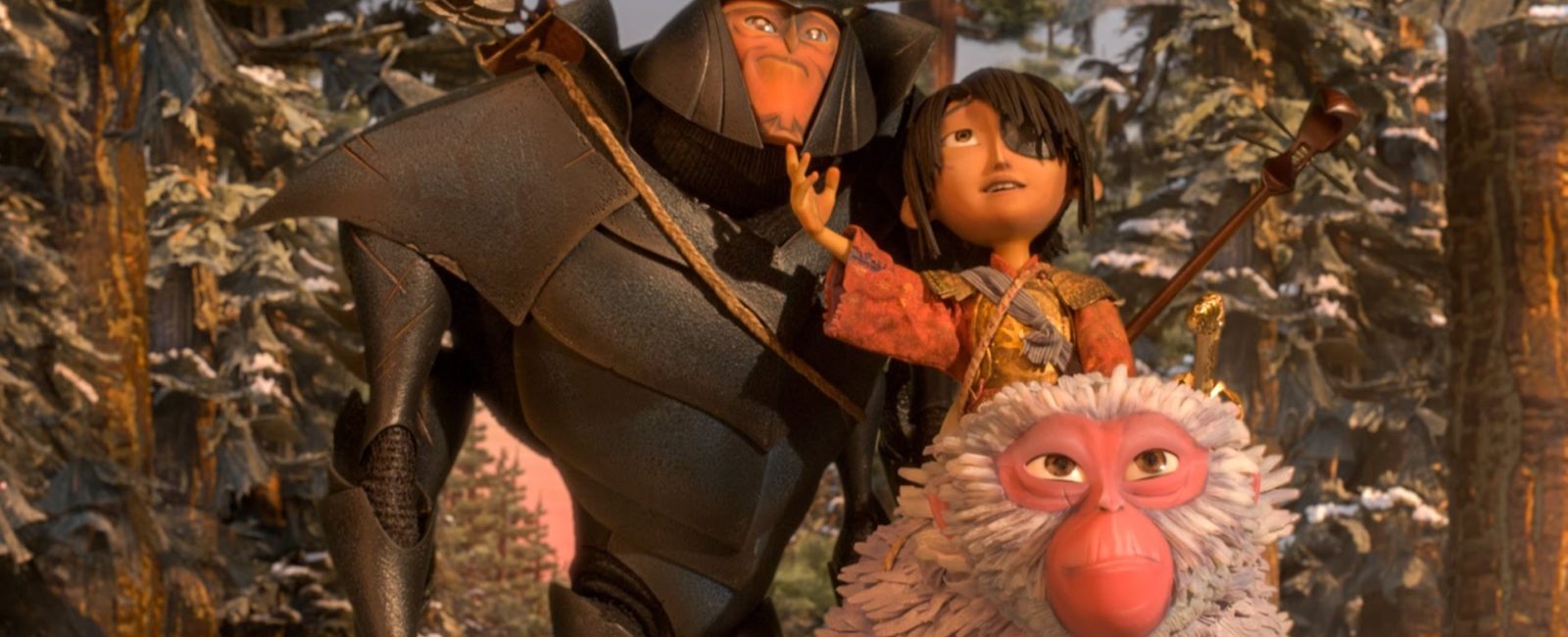
On the craggy shores of a fantastical ancient Japan, a boy named Kubo lives on a high cliff above the sea. A scruffy street urchin who is always clever and kindhearted, Kubo (voiced by Art Parkinson of Game of Thrones) ekes out a humble daily living, mesmerizing townspeople of a small fishing village with his magical gift for spinning wild tales out of folded origami.
Among the villagers he enthralls with his stories are Hosato (George Takei), Hashi (CaryHiroyuki Tagawa) and Kameyo (Academy Award nominee Brenda Vaccaro). By night, Kubo tends to his fading yet regal mother as she slips into trances that seem ruled by the rising and setting moon.
This relatively quiet existence is shattered when Kubo accidentally summons a spirit from his past which storms down from the heavens to enforce an age-old vendetta. Now on the run, Kubo joins forces with the fierce, no-nonsense Monkey (Academy Award winner Charlize Theron) and the quixotic insect samurai Beetle (Academy Award winner Matthew McConaughey), and sets out on a thrilling quest to solve the mystery of his fallen father, the greatest samurai warrior the world has ever known. Kubo must find the coveted items left behind by his father: The Armor Impenetrable, The Sword Unbreakable, and The Helmet Invulnerable.
With the help of his new friends and his cherished shamisen – a magical musical instrument – Kubo’s odyssey winds through howling blizzards in The Far Lands, the underwater Garden of Eyes, and the dangerous Bamboo Forest. Learning of his own magical powers with every new test of strength and character, Kubo must battle gods and monsters, including the vengeful Moon King (Academy Award nominee Ralph Fiennes) and the evil twin Sisters (Academy Award nominee Rooney Mara), to unlock the secret of his legacy, reunite his family, and fulfill his heroic destiny.
Over the five years it took to bring the project to the screen, Kubo and the Two Strings grew as a love letter to Japanese culture from the entire team of artists, technologists, engineers, and craftspeople. The look of the movie is inspired by classic Japanese art and, in particular, Japanese woodblock printing. The latter’s sawtooth patterns, the strong linear striations, intense but simple color palette, and rough-hewn texture were inspired by the work of woodblock masters including Katsushika Hokusai and, in particular, Kiyoshi Saito.
Tindle created all the character designs, noting that “the characters reflect a simple yet powerful silhouette quite different than anything we had seen in a stop-motion film before – and my appreciation of Japan and its art and culture.”
Knight’s own reverence for Japanese art and culture dates back over 30 years ago. “I took my first trip to Japan with my father when I was around eight years old. Growing up in America’s Pacific Northwest, in many ways Japan felt like home, but in other, striking ways it was unlike anything I had ever experienced. It was beautiful, breathtaking, almost otherworldly. The architecture, the art, the style of dress, the music, the food, the movies and television shows and comic books…It was a revelation. I was utterly in its thrall.”
Knight amassed a collection of manga comics to take back home, “riveted by the gorgeous illustrations and clarity of visual storytelling even though I didn’t understand the language. My childhood introduction was the beginning of a life-long love affair with a great culture. I couldn’t wait to go back, and I have returned many times since.”
He muses, “It’s no coincidence that my first film as a director combines all these things I’ve loved deeply since I was a child: epic fantasy, animation, samurai stories, and the beautiful, transcendent art of Japan, While other kids my age were running the soccer pitch or playing with their Matchbox cars, I was dreaming of Japan and imagining armies of stop-motion samurai. The great filmmaker Zhang Yimou once said that every boy either wants a train set or to make a martial arts movie. I never had a train set.
“In making this movie, Kurosawa towered over all other filmic influences. Spielberg has called Kurosawa a ‘pictorial Shakespeare’ and I believe that to be true. Every frame in a Kurosawa film is like a painting. His composition, cutting, movement, lighting, and shapes were an aesthetic muse on Kubo. But it’s not just how he made movies, it’s what he made movies about – existentialism, humanism and the heroic ideal, such as in No Regrets for Our Youth [1946] – that spoke to me.”
Long revered at the LAIKA studios, legendary animation filmmaker “Hayao Miyazaki inspired me on this movie in a very different way,” Knight recounts. “Miyazaki finds something that he has a fascination with, such as Europe, and he internalizes it, synthesizes it, and weaves it into his art. He’s not documenting, or replicating reality. It becomes his interpretation as represented in his art, an almost impressionistic take that then becomes a leitmotif in a large work.
“The kind of prism that Miyazaki applies to Europe is what I wanted to apply to Japan, offering my view on a place and culture that have been vital to me for so long.”


